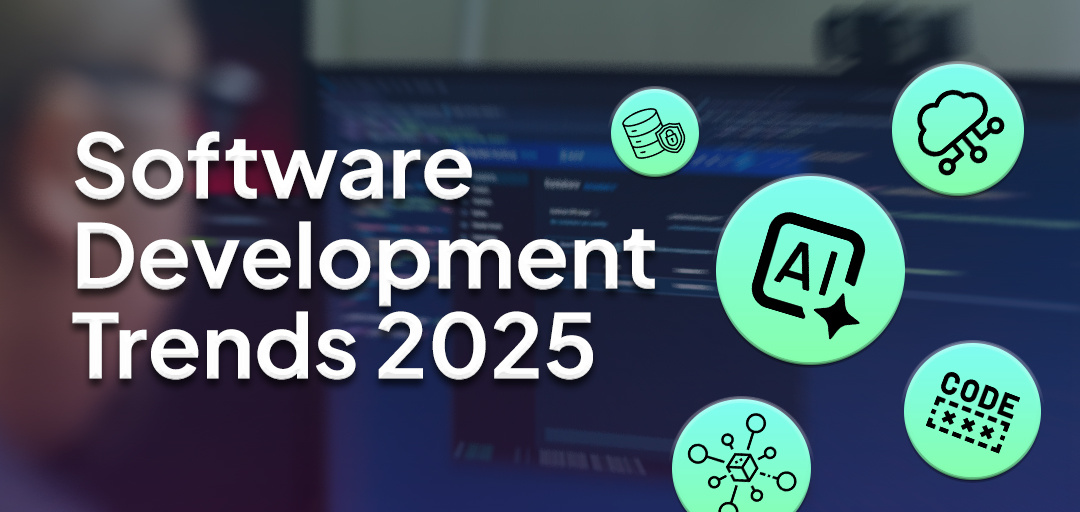Software Development Trends to Watch in 2025: A Guide for Developers

Oct 01, 2024 • 4 min read
As we move into 2025, the world of software development continues to evolve at an incredible pace. For developers, staying ahead of emerging trends is crucial to maintaining a competitive edge and ensuring your skills are relevant. In this post, we’ll take a closer look at the most important software development trends that are shaping the future and what you need to know to leverage them in your projects.
1. AI-Powered Development Tools
Artificial Intelligence (AI) and Machine Learning (ML) are no longer just buzzwords. Recently, they have become deeply embedded into the development lifecycle, from writing code to automating testing and deployment. Tools like GitHub Copilot have already proven how AI can assist developers by suggesting code snippets, identifying bugs, and even automating parts of the development process.
For any developer, embracing AI-driven tools can save time and improve code quality. Expect AI tools to play an even larger role in code completion, documentation generation, and even detecting performance bottlenecks. It’s also becoming more common for AI to provide “smart” refactoring suggestions, improving both the readability and maintainability of your code.
How to make this trend work for you:
- Experiment with AI-based tools like GitHub Copilot, Tabnine, or even AI-powered testing frameworks.
- Explore how AI can optimize your workflow, from documentation to deployment.
2. Serverless Architecture
Also known as Cloud computing, Serverless computing continues to grow. And by 2025, it is expected to be a standard for a significant portion of cloud-native applications. With serverless, developers can focus on writing business logic without worrying about managing servers or infrastructure. Platforms like AWS Lambda, Azure Functions, and Google Cloud Functions are leading the charge.
For developers, serverless architecture offers a way to scale applications efficiently, save on infrastructure costs, and reduce operational overhead. With the rise of edge computing (distributing computing resources closer to users), serverless architectures are expected to become even more relevant for real-time, latency-sensitive applications.
How to make this trend work for you:
- Familiarize yourself with serverless offerings from major cloud providers.
- Design stateless, event-driven services that scale automatically based on demand to achieve scalability, simplified orchestration, and maintainability in a serverless microservices architecture. Use tools like AWS Step Functions for orchestration, API Gateway for service communication, and CI/CD pipelines for seamless deployment and versioning.
3. Edge Computing and Microservices
As applications become more distributed and require low-latency interactions, edge computing is gaining traction. This involves processing data closer to the user (on local servers or devices) rather than relying solely on centralized data centers. In tandem with this, microservices architecture is continuing to take hold as developers aim to build more modular, scalable, and maintainable applications.
Microservices break down monolithic apps into smaller, independent services that can be developed, deployed, and scaled individually. This decoupling results in faster iteration, more flexible scaling, and better fault isolation. Together with edge computing, microservices will become even more integral in providing fast, localized, and fault-tolerant applications.
How to make this trend work for you:
- Get comfortable with microservices architecture and tools like Kubernetes for container orchestration.
- Investigate edge computing platforms (such as Cloudflare Workers or AWS Lambda@Edge) and explore how they can optimize your apps.
4. Low-Code and No-Code Development
Low-code and no-code platforms have been gaining popularity, particularly among non-technical users who want to build applications without writing much code. However, by 2025, these platforms will continue to evolve, offering more advanced features and better integrations for professional developers. These platforms are expected to become powerful tools for speeding up development cycles, enabling rapid prototyping, and even handling backend infrastructure.
While you may not abandon your coding skills, learning how to integrate low-code/no-code tools into your development workflow can dramatically increase your productivity and help you deliver products faster.
How to make this trend work for you:
- Explore low-code/no-code platforms like Webflow, Bubble, or OutSystems to streamline specific tasks.
- Leverage these tools for prototyping or quickly building MVPs to reduce development time.
5. Privacy-First Development
With growing concerns about data privacy and the increasing number of regulations (such as GDPR and CCPA), privacy-first development is not just a trend but a requirement, especially in Europe. In 2025, developers will need to prioritize building secure, privacy-conscious applications that minimize data collection and maximize user control over their information.
For developers, this means using encryption, anonymizing data, and being transparent about data usage. Privacy-first features, such as secure authentication and data encryption, will become standard practice in the industry. So when coding, don’t forget to incorporate data-privacy-specific regulations, such as:
- Right to Be Forgotten – allow users a self-service account deletion option
- Minimized Data Collection – reduce tracking scripts and only store necessary user details
- Strict Access Controls – use role-based permissions by limiting access to sensitive data and maintaining Least Privilege Approach
- End-to-End Encryption – ensure private messaging on message-based apps and programs
- Consent Management – provide clear opt-ins for users
How to make this trend work for you:
- Stay updated on international privacy laws and ensure your applications are compliant by following reliable sources like The Privacy Advisor Podcast, or go to the direct sources such as the GDPR website and CCPA website.
- Implement robust security features, such as end-to-end encryption and privacy-focused authentication methods.
6. Progressive Web Apps (PWAs)
Progressive Web Apps (PWAs), over the years, are becoming a go-to solution for businesses and developers who want to create cross-platform apps without the complexity and cost of maintaining separate native apps. PWAs combine the best features of both web and mobile apps, offering offline capabilities, push notifications, and fast loading times.
By 2025, PWAs will be even more prevalent due to the growing need for apps that work seamlessly on any device, with minimal development effort. PWAs will be especially important for eCommerce, content-heavy platforms, and applications targeting users in areas with poor network connectivity.
How to make this trend work for you:
- Master PWA development and familiarize yourself with service workers, caching strategies, and responsive design.
- Consider converting an existing web app into a PWA to improve user experience and performance.
Conclusion
As a developer in 2025, the key to success will be staying agile and continuously improving your skill set. By embracing new technologies like AI-driven development tools, serverless architectures, and PWAs, you can position yourself to take full advantage of the exciting opportunities ahead. By building expertise in these trends, you’ll not only stay ahead of the curve but also become a more effective and efficient developer.
For more insights and industry trends from our experts and leaders, follow our socials.
NEWS AND BLOG
Resources for boosting
your business

Software Development Trends to Watch in 2025: A Guide for Developers
As we move into 2025, the world of software development continues to evolve at an incredible pace. F…
Read more..

Top 5 Myths About Sales Outsourcing – Debunked!
Sales outsourcing has become an increasingly popular strategy for businesses looking to boost effici…
Read more..

Meet our Dev, Fred
Meet Fred! 👋 He's been with CC.Talent for 3 and a half years, working as a Fullstack Developer spec…
Read more..
REQUEST A QUOTE
Start building your winning team for the now and next
Lorem ipsum dolor sit amet, consectetur adipiscing elit, sed do eiusmod tempor incididunt ut labore et dolore magna aliqua. Ut enim ad minim veniam, quis nostrud exercitation
.png?width=4394&height=835&name=CC.Talent%20-%20without%20tagline%202%20(1).png)
